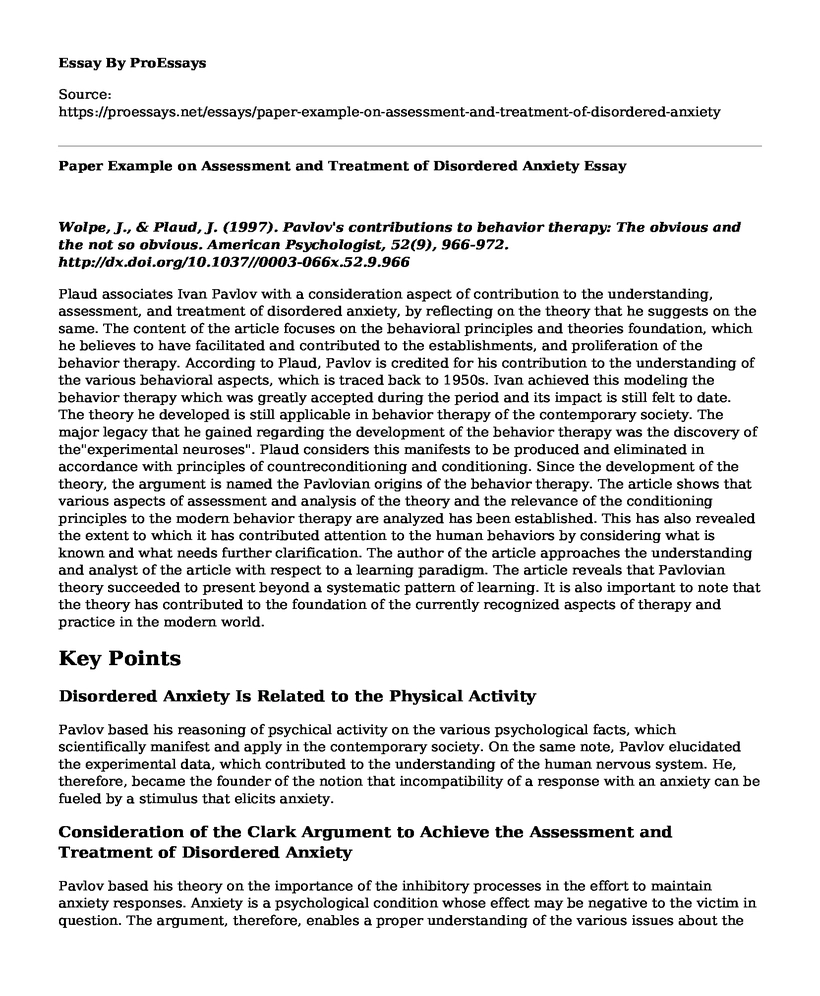Wolpe, J., & Plaud, J. (1997). Pavlov's contributions to behavior therapy: The obvious and the not so obvious. American Psychologist, 52(9), 966-972. http://dx.doi.org/10.1037//0003-066x.52.9.966
Plaud associates Ivan Pavlov with a consideration aspect of contribution to the understanding, assessment, and treatment of disordered anxiety, by reflecting on the theory that he suggests on the same. The content of the article focuses on the behavioral principles and theories foundation, which he believes to have facilitated and contributed to the establishments, and proliferation of the behavior therapy. According to Plaud, Pavlov is credited for his contribution to the understanding of the various behavioral aspects, which is traced back to 1950s. Ivan achieved this modeling the behavior therapy which was greatly accepted during the period and its impact is still felt to date. The theory he developed is still applicable in behavior therapy of the contemporary society. The major legacy that he gained regarding the development of the behavior therapy was the discovery of the"experimental neuroses". Plaud considers this manifests to be produced and eliminated in accordance with principles of countreconditioning and conditioning. Since the development of the theory, the argument is named the Pavlovian origins of the behavior therapy. The article shows that various aspects of assessment and analysis of the theory and the relevance of the conditioning principles to the modern behavior therapy are analyzed has been established. This has also revealed the extent to which it has contributed attention to the human behaviors by considering what is known and what needs further clarification. The author of the article approaches the understanding and analyst of the article with respect to a learning paradigm. The article reveals that Pavlovian theory succeeded to present beyond a systematic pattern of learning. It is also important to note that the theory has contributed to the foundation of the currently recognized aspects of therapy and practice in the modern world.
Key Points
Disordered Anxiety Is Related to the Physical Activity
Pavlov based his reasoning of psychical activity on the various psychological facts, which scientifically manifest and apply in the contemporary society. On the same note, Pavlov elucidated the experimental data, which contributed to the understanding of the human nervous system. He, therefore, became the founder of the notion that incompatibility of a response with an anxiety can be fueled by a stimulus that elicits anxiety.
Consideration of the Clark Argument to Achieve the Assessment and Treatment of Disordered Anxiety
Pavlov based his theory on the importance of the inhibitory processes in the effort to maintain anxiety responses. Anxiety is a psychological condition whose effect may be negative to the victim in question. The argument, therefore, enables a proper understanding of the various issues about the human anxiety.
Responding to the Disordered Anxiety
There are appropriate ways through which people can adjust to the psychological problems arising from anxiety. A psychologist should be able to identify an anxious person provides him or her with the applicable therapies to ensure relief from the condition. Pavlov suggested muscle relaxation be considered in the initial stages of the therapy after identifying whoever is suffering from the given condition.
The Role of the Eysenck's Theory
Pavlov contributed to the understanding of the human theoretical concepts as provided by Eysenck. The Pavlovian theory manifested as an extension of Eysenck's input on the same, by reflecting on it and expanding on its existence. Pavlov there contributed to the understanding of the types of personality associated with human beings.
Treatment of Psychopathology Lies in the Understanding of the Pavlovian Theory
Even though many versions of suggestion exist about applying therapy to the anxiety related conditions, the contribution of the given theory is very clear. It is therefore adopted by many psychologists who tend to intervene in the carious psychology based problems.
Cite this page
Paper Example on Assessment and Treatment of Disordered Anxiety. (2022, Apr 18). Retrieved from https://proessays.net/essays/paper-example-on-assessment-and-treatment-of-disordered-anxiety
If you are the original author of this essay and no longer wish to have it published on the ProEssays website, please click below to request its removal:
- Analyze Thy Self Essay Example
- Multicultural Counseling Essay Example
- Essay Sample on Personality: Nature vs Nurture
- Reflective Paper on Schizophrenia
- Personality Theory: Unlocking Workplace Behavior & its Benefits to HR - Essay Sample
- Paper Sample on Help Children Living with Schizophrenia Adapt to Society
- The Right Age for Drinking or Smoking Onset - Essay Sample







